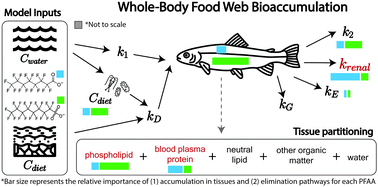A food web bioaccumulation model for the accumulation of per- and polyfluoroalkyl substances (PFAS) in fish: how important is renal elimination?†
Abstract
Per- and polyfluoroalkyl substances (PFAS) are a large class of highly fluorinated anthropogenic chemicals. Some PFAS bioaccumulate in aquatic food webs, thereby posing risks for seafood consumers. Existing models for persistent organic pollutants (POPs) perform poorly for ionizable PFAS. Here we adapt a well-established food web bioaccumulation model for neutral POPs to predict the bioaccumulation behavior of six perfluoroalkyl acids (PFAAs) and two perfluoroalkyl ether acids (HFPO-DA, 9-Cl-PF3ONS) produced as PFAA replacements. The new model includes sorption to blood plasma proteins and phospholipids, empirically parameterized membrane transport, and renal elimination for PFAAs. Improved performance relative to prior models without these updates is shown by comparing simulations to field and lab measurements. PFAS with eight or more perfluorinated carbons (ηpfc ≥ 8, i.e., C8 perfluorosulfonic acid, C10–C11 perfluorocarboxylic acid, 9-Cl-PF3ONS) are often the most abundant in aquatic food webs. The new model reproduces their observed bioaccumulation potential within a factor of two for >80% of fish species, indicating its readiness to support development of fish consumption advisories for these compounds. Results suggest bioaccumulation of ηpfc ≥ 8 PFAS is primarily driven by phospholipid partitioning, and that renal elimination is negligible for these compounds. However, specific protein binding mechanisms are important for reproducing the observed tissue concentrations of many shorter-chain PFAAs, including protein transporter-mediated renal elimination. Additional data on protein-binding and membrane transport mechanisms for PFAS are needed to better understand the biological behavior of shorter-chain PFAAs and their alternatives.

- This article is part of the themed collections: Recent Open Access Articles, Environmental exposure and impacts and Best Papers 2022 – Environmental Science: Processes & Impacts


 Please wait while we load your content...
Please wait while we load your content...